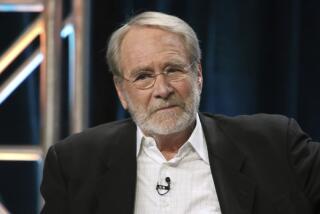Louise Mudd Arehart, 84; Kin of Notorious Physician
- Share via
Her name was Mudd, and she devoted much of her life to defending the reputation of her notorious grandfather and ensuring that his historic Maryland home was preserved.
Louise Mudd Arehart, a granddaughter of the Maryland country doctor who treated John Wilkes Booth’s broken leg after he assassinated President Abraham Lincoln, died of complications from a stroke March 11 in La Plata, Md. She was 84.
Dr. Samuel A. Mudd, charged as a conspirator in the assassination of Lincoln, was sentenced to life in prison in 1865 by the military court that tried the seven men and one woman accused of plotting to kill the president.
Mudd received a life sentence at the Ft. Jefferson prison on the Dry Tortugas, an isolated group of keys 70 miles west of Key West. But in 1869, after heroically saving the lives of prisoners and guards during a yellow fever epidemic, Mudd was pardoned by President Andrew Johnson.
Although the doctor was set free--he died of pneumonia in 1883 at age 49--the debate over his guilt or innocence continues to this day, and members of the Mudd family have spent decades trying to have the government exonerate their forebear.
“Suppose he wouldn’t have set Booth’s leg. What would history have said about him then?” Arehart once asked. “He took a Hippocratic oath of service to humanity.”
Until the end, she remained a strong proponent of her grandfather’s innocence.
“Vociferously, pugilistically,” said Arehart’s daughter-in-law, Suzanne Cox. “You didn’t want to mess with her on that. A lot of politicians got tired of trying to deal with her. She would just wear them down. She had super energy.”
Much of Arehart’s energy over the last three decades went into the preservation of the Dr. Samuel A. Mudd House, a two-story white frame structure that was placed on the National Register of Historic Places in 1983 and operates as a museum.
The house on farmland near the town of Waldorf, about 20 miles south of Washington, draws about 3,000 visitors a year from all over the world.
The restored home is decorated with period furnishings, some of which are from the time the Mudds lived there, including the plush red couch Booth sat on while Mudd tended to his broken leg.
The youngest of nine children, Arehart was born and raised in her grandfather’s house, which has always attracted curiosity seekers. She once recalled that when people walked up to the door, her mother would invite them in and give them a tour.
During World War II, Arehart worked as a civilian in the Pentagon. After the war, she ran a tourist home in Waldorf, served as a judge in the Charles County Orphan’s Court and worked in real estate.
But in the late 1960s, a decade after moving to La Plata, she began her campaign to preserve the old Mudd homestead 10 miles away.
And, Arehart said, it was a ghostly visitor approaching her home that motivated her.
“This man was slender ... he had an old-fashioned brown coat and cap on,” she said. “I went to the front door so I could meet the man. But he wasn’t there. I also went outside, but there were no footprints on the ground.”
After several more appearances she was convinced the mysterious figure was her grandfather.
“One day I was just sitting in my living room, and it hit me. I just had to make Grandpa’s house a historical site that everyone could appreciate,” she recalled.
In 1975, the Maryland Historic Trust bought the 10-acre property, and four years later the state General Assembly appropriated $125,000 for restoration.
Until she suffered a stroke in September, Arehart was a familiar sight at the Mudd House, greeting visitors and escorting them through the rooms as she told her grandfather’s story.
After shooting Lincoln in the presidential box at Ford’s Theater on April 14, 1865, Booth jumped onto the stage, snagging a spur in the bunting and breaking his leg in the fall.
An accomplice, David E. Herold, joined up with Booth in Maryland, where they stopped at Mudd’s house about 4 a.m. to have the 32-year-old doctor tend to Booth’s leg.
After setting, splinting and bandaging the leg, Mudd reportedly asked his handyman to make crutches and sent the two men to an upstairs bedroom to sleep. Late that afternoon, they left on horseback.
Eleven days later, Booth was shot and killed after being surrounded in a barn by soldiers, and Herold surrendered.
Mudd, a Confederate sympathizer, was no stranger to Booth; they had met several times. But although some historians say the two met on secret Confederate matters, Mudd’s descendants and others say the meetings were for innocent social and business reasons.
Mudd maintained that he did not recognize Booth, who used a false name, because he was wearing false whiskers. The doctor also said he didn’t know about Lincoln’s assassination until he went to town after Booth had gone to bed.
The next day at church Mudd reportedly asked a relative to tell the authorities that two “strangers” had been at his home the day before.
Arehart’s cousin, Richard D. Mudd, a 101-year-old former Saginaw, Mich. physician, has led the long crusade to clear their grandfather’s name. He argues that the Military Commission had no jurisdiction to try a civilian and that Samuel Mudd’s conviction should be set aside.
Richard Mudd recently won the right to appear before a federal appeals court in Washington. A hearing date is pending.
Arehart is survived by her two children, Shirley Cox Cook of Wallingford, Pa., and Bernard Cox of La Plata; three sisters; seven grandchildren; six great-grandchildren; and six great-great-grandchildren.
More to Read
Sign up for Essential California
The most important California stories and recommendations in your inbox every morning.
You may occasionally receive promotional content from the Los Angeles Times.













